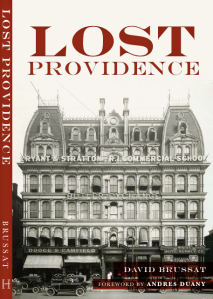Stumbled upon this delightfully informative, well-paced, almost soporific film of Fifth Avenue, taken from the rear window of a motorcar (if they still used that word in the 1930s), at a steady pace except for stops at traffic lights. You’ll almost nod off at the gentle pleasure, grace and repetitiveness of the architecture of the buildings along the avenue, opposite Central Park. Thrill at the elegance of the street lamps, at the absence of “signage,” traffic lights and at the various makes of automobile. At first the camera takes in both sides of the street – for a while you can see the new Empire State Building in the distance – then the camera focuses on the buildings on the east side of the street. Toward the end, Central Park itself takes center stage. The season is spring, with the trees newly abud, seemingly in early afternoon, though it seems to shift with different takes. You can see the “towers” of Central Park South dimly off in the distance.
Here are the details for A Day in New York 1930s:
A time travel in New York 1930s. We can clearly see what is happening in broad daylight, I believe it starts at 51st Street and rides along Fifth Avenue for the rest, right next to Central Park.
Video Restoration Process:
- FPS boosted to 60 frames per second
- Image resolution boosted up to HD
- Improved video sharpness and brightness
- Colorized only for the ambiance (not historically accurate)
- added sound only for the ambiance
- restoration: (stabilisation,denoise,cleand,deblur)
Please, be aware that colorization colors are not real and fake, colorization was made only for the ambiance and do not represent real historical data. Thanks to A/V Geeks for share the amazing B&W Video Source B&W Video Source from: A/V Geeks on archive.org B&W Video Source: https://archive.org/details/pet1019r1ny




Pingback: Wharton’s “House of Mirth” | Architecture Here and There
Dear David,
That was delightful to see! Thanks for sharing this.
As one who knows well that stretch of fifth Avenue, here are a few observations:
What we’re seeing are actually three films in succession, covering the same territory, but from different angles—
The first film, in which the camera is facing South (looking straight-down Fifth Avenue), the second, in which the camera is facing South-East (so as to capture the buildings that line the East side of Fifth Avenue), and the third, in which the camera faces South-West (so as to capture the other side of Fifth Avenue: the broad sidewalk that runs along the edge of Central Park)
How does one know this?? Well, one sees the Morgan library twice (from when the film covers the Southward and then the South-Eastward views), and one can see the Richard Morris Hunt Memorial twice (when the film covers the Southward and then the Southwestward views).
Since 1966, traffic on Fifth Aveune has only run Southwards—but in this film, you can that the road is shared by traffic that’s running both North and South. I recall hearing that some protested that change (from two-way traffic to one-way), projecting that the one-way mode would make the traffic more relentless & fast (and hence less civilized). I can’t say they were wrong.
Was this taken from an auto? The lack of glare or any distortion from auto windows makes me suspect that it was taken from a camera mounted on the back of an open truck.
These days, we’re quite used to seeing professional films being made in NYC, but 90 years ago, it would have been something to remark upon—and when our camera vehicle stops for a traffic light, one can see some workmen staring right into the lens (as though it was quite unusual for them to be on camera, as indeed it would have been).
To make these three views, did they have three cameras? Hmmm. Since cameras were expensive, I’m wondering if they saved money on equipment, and just used one—and made the trip three times.
Calder, quite rightly, mourns the loss of the mansions on 5th Avenue. By the time this film was made, most of the really big ones were gone—and in this film you can see the large, traditionally-styled apartment houses that replaced them (which are still there).
But what one also sees in this film are empty lots, surrounded by construction “barricades”—and I’m suspecting that those lots held recently-demolished big mansions, and they were now cleared for apartment house construction. But—
But I wonder if, this being the Depression, if some of those empty lots waited until later economic conditions improved, before getting an apartment house finally built on them. Between the Depression and WWII, the resources to build again wouldn’t have have been available until the later half of the 1940’s—and maybe that accounts for the mid-century modern apartment houses that one sees on Fifth Avenue.
Even so, with the big, ultra-grand mansions gone, the film shows a lot of truly fine townhouses—and I’m happy to attest that a fair number of them are still there!
The best thing here—design-wise—are the autos!
Respectfully submitted,
Seth J. W.
Seth Joseph Weine
sethweine@aol.com
= = = =
LikeLike
Glad you enjoyed this, Seth, and thanks for your penetrating observations. I was wondering whether some of the buildings with sharp rectangular blocks and windows with little setback from the facade could be classified as modern. I would say not, but maybe some amalgam, with classicist firms trying to find areas of compromise with modernist trends.
LikeLike
Dear David,
About those buildings, in that 1930’s film, which might look a bit Modern.
It’s hard to tell. I have a saying about buildings—
“Buildings are just like human bodies: as they get older, things happen to them—generally not good things.”
So sometimes, when we’re looking at buildings (including mannnny NYC buildings), we may be looking at one that got some kind of renovation of alteration to its look. For example: There are plenty of NYC townhouses that were modernized (as their time understood it) from Greek Revival –to– some flavor of Italianate or Victorian. And there are numerous buildings that had their facades ruthlessly simplified—and that applies to buildings of all scales: certainly some townhouses and smaller apartment houses, but also large ones too: the body of the tower of Metropolitan Life Insurance Company (which towers over 23rd Street and Madison Square Park underwent such a transformation.
So—
It’s possible that the buildings you’re thinking of were subject to some such geometric-zation makeover.
All the best,
Seth J. W.
Seth Joseph Weine
LikeLike